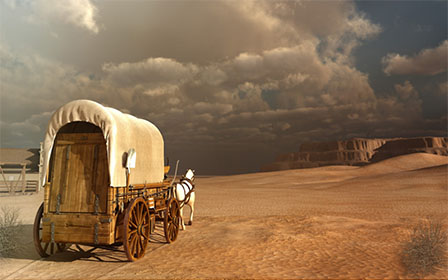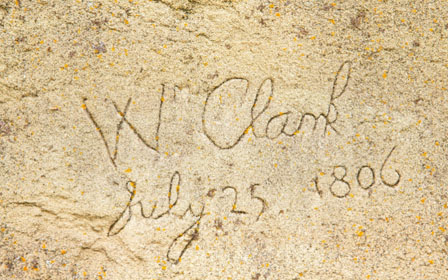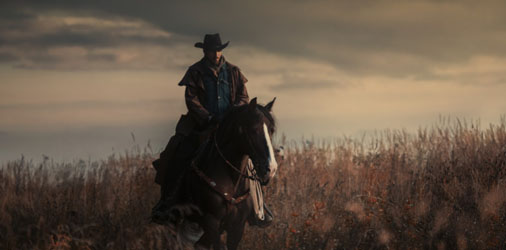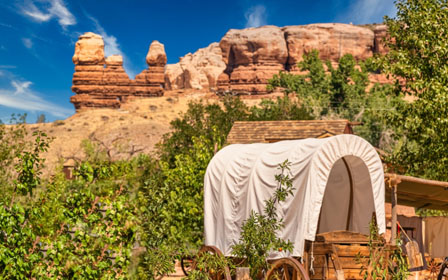HOW THE WEST WAS WON
Using Literature to Enhance the Study of Westward Expansion
Introduction | Background Knowledge | Activities | Extensions | Standards

Introduction
The Wild West is synonymous with adventure. There are visions of cowboys and tumbleweeds and stories of bandits and shootouts in the OK Corral. An average person could go to California and get rich, panning for gold. An entire generation of students learned about going west by playing Oregon Trail on their DOS computers. The United States expanded from the original 13 colonies, clustered along the East Coast over the course of roughly 100 years. Because of it, our nation now spans from “sea to shining sea.”

Background Knowledge
The American story has been one of westward expansion since the Colonists landed at Jamestown in 1607. With an ocean to the east, there was nowhere to go but west. In America’s infancy, the Mississippi River was the western boundary of the new nation. When President Thomas Jefferson purchased a large parcel of land in 1803, known as the Louisiana Purchase, the era of Westward Expansion began. By 1853, with the Gadsden Purchase, all of the lands that would become the Contiguous 48 states had been acquired. Visual Capitalist shared an interactive map showing how the United States grew and expanded from 13 colonies to the 50 states of the present. The era of the Westward Expansion ended in 1912 when Arizona was admitted as the last of the 48 contiguous states.
As the new land was acquired, white settlers began to move West. They moved with the notion of “Manifest Destiny.” Coined in 1845 by a newspaper editor, “manifest destiny” was the belief that Americans had a divine right to move west and expand the United States. The movement was based on the idea of superiority over other people, and that white Americans were to bring culture and civilization to the “uncivilized” people who already inhabited the west. The idea of “Manifest Destiny” brought many technological advances to the United States - from the Erie Canal to the telegraph and Pony Express to the Transcontinental Railroad.
The progress that came with expansion also came at a high cost. “Manifest Destiny” also brought the Indian Removal Act of 1830 and the Trail of Tears. Tens of thousands of Native Americans were forced from their land and relocated to reservations to live lives of hardship and poverty that extends into the present day.

ACTIVITIES
Selective List of Picture Books
-
Dandelions by Eve Bunting (ISBN 9780152024079)
- Zoey and her family have moved west to the Nebraska territory from their home in Illinois. Three hours from their nearest neighbor and a day’s ride from town, Zoey’s mama is struggling with pioneer life. On a trip to town for supplies, Zoe finds a bunch of dandelions growing on the plain. She has an idea of how to cheer up her mama and make their sod house a little more inviting.
- Dandelions is a very long book, approximately 20 minutes to read aloud. Keep this in mind as you are planning to share it with students.
-
Carol Hurst’s Children’s Literature Site (TeachersFirst review) has several questions for discussion:
- What are the various needs of the characters in this book? What other books talk about similar conditions?
- What makes a place home for you? What material things from your present home would you place near you in a new one to make it feel like home? Is it something you could have had in the time in which this book is set?
- Imagine your family transported back in time to a dwelling like the one in Dandelions. Which members of your family would adapt best to the conditions there? What about yourself?
- The dandelions may also represent caring and love for her mother on the part of the daughter. Have you ever used a flower or something equally simple to show the same? Has something similar ever been done for you?
-
Connect to STEM and build a Sod House.
- Read more at Nebraska Public Media about building a sod house
- Connect to a Nonfiction Minute about sod houses. This site also has an audio component.
- Our Story, through the Smithsonian Institute, gives more information about sod houses.
- Build a sod house out of Rice Krispies treats or brownies.
-
Covered Wagon, Bumpy Trails by Verla Kay (ISBN 9780399229282)
- This easy rhyming book gives a simple view of life in a covered wagon on the way to the Sacramento Valley.
- Find more information at Ducksters (TeachersFirst review) There are 10 question quizzes to check comprehension for the various sections.
-
A Book for Black-Eyed Susan by Judy Young (ISBN 9781585364633)
- Cora first loses her mother on the wagon train and then loses her baby sister when her father asks her aunt to raise her. She makes a quilt book for her baby sister.
- Encourage students to explore packing their own wagons. Use the recommended food per person list and packing your covered wagon worksheet to see the sacrifices the pioneers had to make to move west.
- Learn more about life in the covered wagon from the National Oregon/California Trail Center.
- Pair with the nonfiction text Daily Life in a Covered Wagon by Paul Erickson (ISBN 9780140562125)
-
The Sweetwater Run: The Story of Buffalo Bill Cody by Andrew Glass (ISBN 9780385322201)
- This book tells the story of how Buffalo Bill Cody became the youngest rider on the Pony Express.
- Explore the Pony Express and earn the Junior Ranger Badge through the National Park Service.
- Take a virtual tour at the Pony Express National Museum in St. Joseph, Missouri.
- Share a video about The Pony Express.
- Pair with the nonfiction text The Pony Express by Amy C. Rea (ISBN 9781680782592)
-
Minnow and Rose: An Oregon Trail Story by Judy Young (ISBN 9781585364213)
- Look through the teaching guide provided by Cherry Lake Publishing. Pages 6, 8, and 13 have discussion questions for the story.
- Play the original Oregon Trail computer game. Discuss the choices that players have to make throughout the game.
- Integrate primary sources to explore the Oregon Trail.
- Pair with nonfiction text Surviving History: Oregon Trail by Virginia Loh-Hagan (ISBN 9781534180284). This book is easily accessible to students in third grade and up. It has a choose your own adventure quality and provides excellent information.
-
The Journey of York: The Unsung Hero of the Lewis and Clark Expedition by Hasan Davis (ISBN 9781543512823)
- York was the only enslaved man to join Lewis and Clark on their expedition west. He became respected, and the leaders of the expedition came to rely on him throughout the journey.
- Analyze primary sources to learn more about the Lewis and Clark Expedition.
- Learn more about York in this video from the Lewis and Clark Historical Park.
- Students can earn a Junior Ranger Badge through the National Parks Service.
- Thomas Jefferson gave Lewis and Clark very detailed directions about what to look for on their expedition west. The Jefferson Monticello shares Jefferson’s directions to Lewis and Clark and offers eleven activities to extend a unit on the Westward Expansion.
- Pair with the nonfiction text National Geographic Readers: Sacagawea by Kitson Jazynka (ISBN 9781426319631) Use this TeachersFirst Reading Trek and map link to help students see how the Lewis and Clark Expedition traveled across the country. There are important points for York and Lewis and Clark to explore.
Selective List of Chapter Books
-
Dear America series
- Across the Wide and Lonesome Prairie: The Oregon Trail Diary of Hattie Campbell, 1847 by Kristiana Gregoy (ISBN 9780590226516)
- Behind the Masks: The Diary of Angeline Reddy by Susan Patron (ISBN 9780545304375)
- Scholastic provides great background on the era of Westward Expansion.
-
Ranger in Time #1: Rescue on the Oregon Trail by Kate Messner (ISBN 9780545639149)
- Ranger is a search and rescue dog who travels back in time and helps the Abbot family on their journey west.
- Invite Kate Messner into the classroom for a virtual author’s visit! She can visit through skype for a small fee and can be reached here or watch a recording of a visit here. Use her suggestions to encourage students to write their own stories about Westward Expansion.
- Follow the Oregon Trail on this map from Nebraska Public Media. The article is also full of information about the trail, and there is a short video with more information. Pair with the nonfiction text Voices from the Oregon Trail by Kay Winters (ISBN 9780803737754)
- Nettie and Nellie Crook: Orphan Train Sisters by E. F. Abbott (ISBN 9781250068354)
-
A Family Apart by Joan Lowry Nixon (ISBN 9780440226765)
- Both titles follow children as they embark on a journey west on the Orphan Trains that shuttled orphans and unwanted children to families in frontier towns.
- Using maps, graphs, and infographics, learn more about the Orphan Train Movement from Storymaps.
- Learn more with this Scholastic Action article.
- This expansive lesson plan provides technology approaches and non-technology approaches to exploring Orphan trains.
- Introduce students to digital curation. Students can make their own with Milanote (TeachersFirst review).
- Pair with the nonfiction text Orphan Train Rider by Andrea Warren (ISBN 9780395913628)
-
Sarah Plain and Tall by Patricia MacLachlan (ISBN 9780062399526)
- Anna and Caleb get a new mother when Papa puts an ad in the paper for a bride. Sarah joins the family from her home in the east and learns how to live on the prairie.
- Scholastic published an excellent Reading Guide with discussion questions, recipes, and extension activities.
- Find more information about mail-order brides from the Smithsonian National Postal Museum.
-
Compare and contrast life in the East to life in the West.
- Technology Approach - Use Canva (TeachersFirst review) to create a digital Venn Diagram.
- Non-technology Approach - Use hula hoops and sentence strips to make a Venn Diagram an activity for the whole class. Teachers can provide sentence strips, or students can write one or two facts on their own and place them into the large Venn Diagram.
-
Prairie Lotus by Linda Sue Park (ISBN 9781328781505)
- In 1880, Hanna was a half-Asian girl living on the prairie. She experiences prejudice as she adjusts to life in her new home.
-
Linda Sue Park provides many resources to accompany this book.
- Educator Guide
- The powerpoint presentation is embedded in the purple box near the bottom of the page.
- Additional Resources
-
Book recommendations from Linda Sue Park
- The Birchbark House by Louise Erdrich (ISBN 9780786814541)
- Dragon’s Gate by Laurence Yep (ISBN 9780064404891)
- Bad News for Outlaws by Vaunda Micheaux Nelson (ISBN 9780822567646)
-
Bookpage provides an excellent list of discussion questions that open students’ eyes to stories that are not told. The Quote-Led Discussion section is a great starting point for an honest look at how history sometimes leaves out important perspectives.
- Technology Approach - Use Flip (Teachers First review) to have a digital conversation. Students may open up more in a digital discussion. You can also use Google Jamboard (TeachersFirst review) or Microsoft Whiteboard (TeachersFirst review) to lead a digital graffiti activity. Write quotes on separate pages of the whiteboard, and students can add their thoughts.
- Non-technology Approach - Use the graffiti model to spark conversation. Write the quotes on chart paper and have students walk around the room and add their thoughts.
-
Nathan Hale’s Hazardous Tales
- Blades of Freedom: A Louisiana Purchase Tale (ISBN 9781419746918)
- Alamo Allstars (ISBN 9781419719028)
- Donner Dinner Party (ISBN 9781419708565)
- Page 8 of this teacher’s guide gives excellent discussion questions and cross-curricular activities for Donner Dinner Party and general questions for the entire series on page 9, and a connection to Common Core Standards on page 10.
- Major Impossible (ISBN 9781419737084)
- Encourage students to make their own graphic novels about Westward Expansion.
- Technology Approach - Use Canva (TeachersFirst review) to create a digital comic book.
- Non-technology approach - Provide a graphic novel template for students to create their graphic novels. Download free templates from Lady and the Blog. Scroll to the bottom of the page for six different templates.
Virtual Field Trips and Interactives
- Teaching with the Gold Nugget
- Westward Expansion by PBS Learning Media
- Oregon Trail Nearpod
- History Globe Oregon Trail
Videos to Watch
- Check out The Clever Teacher for five videos about Westward Expansion to share.
- Growth of a Nation
- Share the clips from The West for a different perspective. There are also several middle school lessons on that page under the Classroom tab.
- 10 Westward Expansion Activities for Students

EXTENSIONS
-
Connect to Primary Sources
- The Library of Congress has a collection of primary sources for the Westward Expansion and a Teacher’s Guide. These resources can complement any of the literature suggested above.
-
A Modern Look at a Historical Era
- Students transform into pioneers for this activity and share using modern conveniences like photographs to share their experiences. After learning about Westward Expansion, students choose a year and a persona and then write a journal - complete with pictures - about their experiences. A student can be a child on the Orphan Train or a kid growing up in a pioneer town. A student can choose to travel the Oregon Trail in a covered wagon or live like Hanna in a town where they are not welcome.
- Technology Approach - Use Penzu (TeachersFirst review) to create a digital journal.
- Non-technology Approach - Students can draw or print pictures to share their journeys.
- Packing for a Road Trip Imagine taking a long road trip with family over an upcoming school break where your travels are miles away from modern conveniences. Create a checklist of necessary items for each person and consider how and where the items are to be stored during the driving. Create a Google My Map (TeachersFirst review) to show the travels and any fun stops along the way.
-
Uncovering America: National Gallery of Art
- Use the Narrative and Point of View activities from the National Gallery of Art for Across the Continent and American Exceptionalism concept.

CORRELATION TO STANDARDS
- AASL National School Library Standards
- Inquire Shared Foundation, Think Domain - Learners display curiosity and initiative by: 1. Formulating questions about a personal interest or a curricular topic. 2. Recalling prior and background knowledge as context for new meaning
- Inquire Shared Foundation, Grow Domain - Learners participate in an ongoing inquiry-based process by: 1. Continually seeking knowledge
- Include Shared Foundation, Create Domain - Learners adjust their awareness of the global learning community by:. 2. Evaluating a variety of perspectives during learning activities
- Include Shared Foundation, Grow Domain - Learners demonstrate empathy and equity in knowledge building within the global learning community by: 2. Demonstrating interest in other perspectives during learning activities
- Curate Shared Foundation, Create Domain - Learners gather information appropriate to the task by: 2. Collecting information representing diverse perspectives
- Explore Shared Foundation, Think Domain - Learners develop and satisfy personal curiosity by: 1. Reading widely and deeply in multiple formats and write and create for a variety of purposes. 2. Reflecting and questioning assumptions and possible misconceptions.
- Explore Shared Foundation, Share Domain - Learners engage with the learning community by: 1. Expressing curiosity about a topic of personal interest or curricular relevance
-
ISTE Standards for Students
- Knowledge Constructor - 3d. Students build knowledge by actively exploring real-world issues and problems, developing ideas and theories and pursuing answers and solutions.
